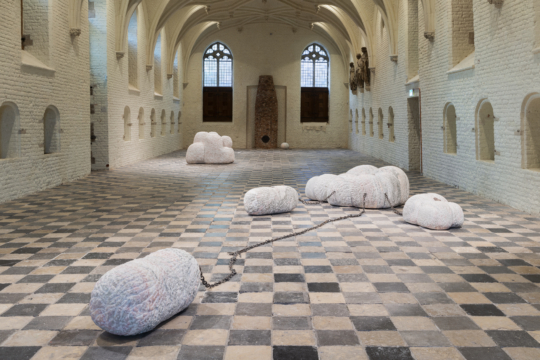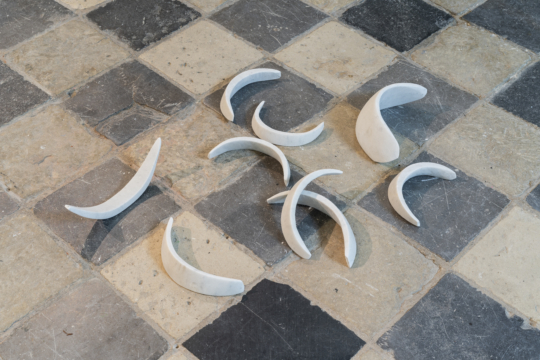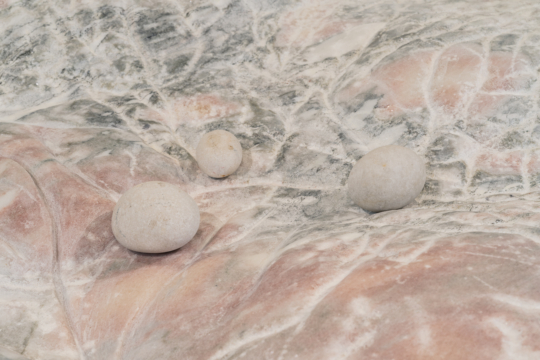
“I have been tamed by the stone,” Emma Jääskeläinen reveals to me during our conversation at the opening of Slo Mo Mother. The exhibition aptly embodies this sentiment. It is a deliberate journey towards slowing down, learning to care and value the mundane.
Upon entering the enchanting Gothic exhibition space of the Vleeshal Center for Contemporary Art, the viewer is greeted with a range of colossal yet leisurely marble stones that almost appear to be sinking into the floor. The sculptures bear a resemblance to solitary rocks tenderly caressed by a tranquil sea. The heaviness of form that yieldingly presses into the ground radiates a sense of docility and serenity. These gentle, round shapes invite the viewer into a state of meditation with the objects. The industrial chains that connect the multiple stones, however, induce a slight tension. Thus, a dichotomy unravels, leaving me to ponder the meaning of Jääskeläinen works.
The narrative that ties together the individual works seems enigmatic. No distinct path is laid out for the observer. No beginning or end. Rather the viewer is thrown into the deep end, where a multitude of meanings is possible. Herein lies Jääskeläinen’s artistic essence: she abstains from imposing a specific narrative on the rock she is carving, rather allowing spontaneity and playfulness to emerge during the process. The title of the exhibition, Slo Mo Mother, however, does hint at a narrative that threads the works together. This notion is reinforced by At Her Fingertips, the first (and central) piece the visitor encounters. The work, consisting of five marble stones that resemble a hand, is loaded with emotion. The ‘fingers’ attached by chains are only loosely connected to the palm, to the degree that one of the stones has become fully detached. The installation deals with the complex, multifaceted nature of human interconnection, expressing both the profound delights of motherly love and affection as well as the poignant concerns and fears of separation. Other works, such as a hand holding a cigarette or nail clippings, by contrast, appear less expressive, simply illustrating varying episodes of one’s daily encounters. Whether these works are made to be interpreted in light of the central piece or on their own is unclear.
Given Jääskeläinen’s emphasis on the value of the mundane, the absence of a clear message or ‘higher’ ideal seems fitting. The work she makes does not represent heroic deeds or ideas but rather highlights ordinary thoughts and emotions. In a world guided by capitalism, which encourages a relentless pursuit of progress and a constant need for speed and improvement, Jääskeläinen’s works offer a refreshing counterpoint. She inspires us to return to a simpler, more relational way of life. Through a slow yet extensive dialogue with the stones her work suggests a mode of creation that avoids the manifestation of human arrogance in favour of humbly surrendering to the wisdom of the material. She does not impose a strict meaning on the stone but rather allows it to slowly guide her. The work of carving marble is an arduous endeavour, demanding immense strength and unwavering dedication. Jääskeläinen approaches this task with trust, skilfully producing surfaces with a remarkable ‘softness’.
Still, Jääskeläinen appreciates the beauty of allowing certain parts to remain rough, as such, enabling a hint of rawness to linger in her work. Her artistic philosophy is not concerned with the pursuit of perfection. Rather her work acknowledges the imperfections, complexities and dichotomies that surround human existence. By embracing rough textures and bulky shapes, Jääskeläinen’s work is also a comment on the traditional ideal of Greek marble statues that have been praised for their elegance, idealistic shape and inspirational character. Contrarily, she invites us to adopt new values that accentuate the beauty and gratification found in the simple and natural.
Despite the extensive use of heavy materials, Jääskeläinen’s works radiate an unexpected feeling of light-heartedness. The sometimes slightly clumsy and rather unwieldy appearance of the artworks offers a whimsical even comical quality, which suggests taking things with ease.
By celebrating the symbiotic relationship between the human and the non-human, between the maker and the material, Jääskeläinen’s work demonstrates the deep effect of nature on the creative process, challenging the traditional idea of the artist as a solitary genius. She accentuates the artist’s interconnectedness with their environment, emphasizing the importance of external forces in shaping the behaviour of the individual. Her work opens up a new avenue for seeing creation as a social and collaborative enterprise in which the artist serves as only one part of the larger whole. Jääskeläinen invites us to reconsider our perception of the world and abandon the notion that humans are the centre of all things. Consequently, her work seems to encourage an important transition away from individualistic ambitions and toward a more compassionate, reflective and collective-minded approach to life.
In this sense the exhibition goes much deeper than the title – Slo Mo Mother – suggests. It is not merely about the complicated experience of motherhood (which undeniably can be one of the meanings) but also about the ability to express patience, care, and acceptance in a world that favours material achievements over relationships. The exhibition, as such, invites us to slow down and reconsider our way of relating to the world around us. Perhaps, we should all be ‘tamed’ by the stone…
Terēze Lība Tiesniece is an intern at the contemporary art department of Stedelijk Museum Breda and a prospective master’s student in Art Curating and Museum Studies

